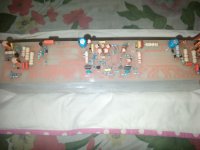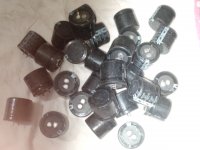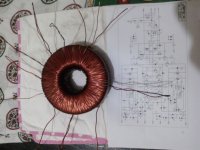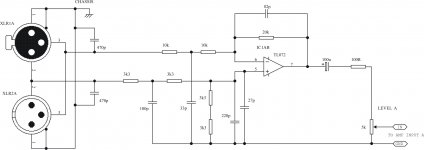maybe ampman
eva
and many diy'er can share
about
smps
a 4x40v
for a compact and lightweight class-h
eva
and many diy'er can share
about
smps
a 4x40v
for a compact and lightweight class-h
My protect circuit use 2x18VAC. There is thermal senzor and power for 24V fan with two speed control, also have +/-15VDC PSU for balanced input circuit.which is better
if i use 24v supply
transformer must have 4x40v +/-15, and another 24v for the fan
if i use another small x-former for fan and protect circuit
what is the desired ampere
Your math is right of course but your thought is wrong. If the transducer goes into power compressing at 34 volts RMS the 152 volts is a complete waste! The point was POWER COMPRESSION sets in at 34 volts RMS and driving the transducer with more voltage only results in heinous distortion.
My point was that a 34 volt RMS *thermal load* requires around 150V swings to accomplish. Power compression goes as average power, over about a two second interval. Crest factor of typical multi-tone waveforms has peaks that are tens of microseconds to tens of milliseconds wide. You just can't get 150W of average power with 50 volt rails. Sinewave yes, but music, no. And 15W average power just won't cut the mustard.
hi engel dela pena
greetings working on 900h my dream project finished
winding my transformer have eto put insulation tape and take leads out
heatsink have to be cut and anodised posting pictures
thanking you
andrew lebon
pcb to be fitted like this
greetings working on 900h my dream project finished
winding my transformer have eto put insulation tape and take leads out
heatsink have to be cut and anodised posting pictures
thanking you
andrew lebon
pcb to be fitted like this
Attachments
OH.
So that begs the question- Why are all these other incredibly stupid designs around when such a good one is available?
The other "incredibly stupid designs" allow all the output transistors to be mounted directly on the heat sink with no insulators. They also have a reduced component count. It's the bean counters at work - trying to make it as cheap as possible.
My point was that a 34 volt RMS *thermal load* requires around 150V swings to accomplish. Power compression goes as average power, over about a two second interval. Crest factor of typical multi-tone waveforms has peaks that are tens of microseconds to tens of milliseconds wide. You just can't get 150W of average power with 50 volt rails. Sinewave yes, but music, no. And 15W average power just won't cut the mustard.
We both have some good points. Power compression occurs extremely rapidly ~2ms when the limit is exceeded so maybe on a horn at 20kHz you could squeeze a 10dB crest through but not down anywhere in a bass or midrange. With increasing signal voltage, using a music or voice, the current decreases above the compression threshold for all practical purposes instantly and sounds horrid just as instantly.
The super easy test I use is this-Connect a voltage probe and a current probe to the speaker and lay the to signals on top of each other on an oscilloscope. Next start increasing the music signal until you see peaks of voltage where the current is decreasing. This is very easy to see as the slope of the current signal becomes the opposite of the voltage signal. That is the voltage limit for the driver. 34 volts peak is the highest voltage I have ever seen using this test before compression sets in. Now I have only tested about 50 drivers this way and not yet tested a 4 inch woofer however woofers never got close to this 34 volt value which is a huge 4 inch compression driver.
Careful destructive testing has shown every driver disassembled had a hot spot that caused the power limit to set in rapidly. Often this was at the end of the voice coil away from where the leads attach where the end of the coil is at the end of the bobbin or the single voice coil wire coming from the main body of the voice coil to where the tinsel lead attach.
Last edited:
The other "incredibly stupid designs" allow all the output transistors to be mounted directly on the heat sink with no insulators. They also have a reduced component count. It's the bean counters at work - trying to make it as cheap as possible.
Bean counter mentality- The single biggest cause of the death of modern society. All value is measured in beans and beans are the only meaningful method of measurement.
H900 Protect include:
1 Anticlick 5sec delay
2 DC cut-out
3 Thermal cut-out on 90deg
4 Fan high speed on 60deg
5 Over current protect (power-on reset)
Conectors:
1 2x18V 500mA AC
2 +/-15V DC stab for XLR circuit
3 PRO overcurrent detect
4 Protect LED
5 Thermal sensor BD241C as diode on heatsink
6 24V DC Fan cooler (12V for low speed)
7 Speaker IN/OUT
1 Anticlick 5sec delay
2 DC cut-out
3 Thermal cut-out on 90deg
4 Fan high speed on 60deg
5 Over current protect (power-on reset)
Conectors:
1 2x18V 500mA AC
2 +/-15V DC stab for XLR circuit
3 PRO overcurrent detect
4 Protect LED
5 Thermal sensor BD241C as diode on heatsink
6 24V DC Fan cooler (12V for low speed)
7 Speaker IN/OUT
andrewlebonhi apex audio
greetings work in progress,will keep u informed
thanking you
andrew lebon
what software are you using in making pcb
or does this h900 pcb is already printable
w/o size change
hi engel dela pena
greetings yes pcb is smaller easy to find components no
software used take out a printout and see if 8pin ic aligns exactly to tracks
accordingly can be enlarged or decreased
thanking you
andrew lebon
greetings yes pcb is smaller easy to find components no
software used take out a printout and see if 8pin ic aligns exactly to tracks
accordingly can be enlarged or decreased
thanking you
andrew lebon
One can use HCPL-0723 for simplicity and less propagation delay at HF switching in Class-H to avoid rail sticking.
can you share protect pcbhi engel dela pena
greetings yes pcb is smaller easy to find components no
software used take out a printout and see if 8pin ic aligns exactly to tracks
accordingly can be enlarged or decreased
thanking you
andrew lebon
engel9mcnaly@yahoo.com
- Home
- Amplifiers
- Solid State
- 900W H-class PA Amp with Limiter
![P2009[01]_24-03-10.jpg](/community/data/attachments/158/158925-47a544be4deb24696905c666a458fd7f.jpg?hash=R6VEvk3rJG)






